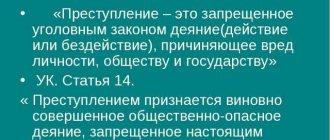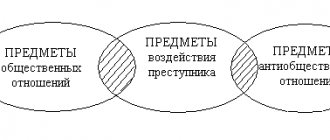The corpus delicti is a set of characteristics that allow the identification of a criminal act. The simultaneous presence of these factors indicates the commission of illegal actions. If at least one of the signs is missing, then it will not be possible to bring the culprit to justice, since the crime was not committed.
Experts distinguish three types of crimes: material, formal and truncated. Below we will talk about truncated elements of crime in the Criminal Code of the Russian Federation.
Elements of the crime
The crime includes 4 elements:
- An object. This concept unites those socially significant institutions that suffer damage as a result of criminal acts. We are talking about public order and security, human rights and freedoms, the environment, personal property, the constitutional system of the state, etc.
- Subject. This is a person who has committed criminal acts. A legally competent citizen who has reached the age of 16 can be held criminally liable. When committing serious and especially serious criminal acts, the minimum age for criminal liability is 14 years. These are illegal actions such as vandalism, riots, murder, robbery, etc.
- Objective side. Expressed in signs characterizing the external manifestation of the crime. We are talking about the method of committing criminal acts, the weapon, the cause-and-effect relationship, etc.
- Subjective side. This is the attitude of the attacker towards the crime committed. Both direct and indirect intent are possible here. Also, criminal acts can be committed unintentionally. Then the citizen is either accused of committing a crime through negligence or receives an acquittal.
Material, formal and truncated compositions
There are three types of crime:
- material;
- formal;
- truncated.
Most criminal acts have a material component. In this case, the moment the crime ends is the onset of socially dangerous consequences. If such an act does not cause negative results, then it is considered either imperfect (the culprit is acquitted) or incomplete (the culprit receives punishment for the attempt).
A striking example of a criminal act with a material component is murder. It can only be considered completed at the time of the victim's death. As long as the victim is alive, the crime will be considered unfinished. However, an attacker will receive punishment for attempted murder if he committed certain actions to achieve a criminal plan, but was unable to complete the matter due to reasons beyond his control.
Unlike the material one, with the formal composition it is not the result that is taken into account, but the very fact of committing a criminal act. It does not matter whether socially dangerous consequences occurred or not. Thus, a formal crime is considered completed at the moment when the attacker has realized his criminal plans. If the actions of the culprit entailed negative consequences, then they will be taken into account as qualifying features or aggravating circumstances.
Have a question for a lawyer? Ask now, call and get a free consultation from leading lawyers in your city. We will answer your questions quickly and try to help with your specific case.
Telephone in Moscow and the Moscow region: +7
Phone in St. Petersburg and Leningrad region: +7
Free hotline throughout Russia: 8 (800) 301-39-20
Some experts believe that a formal crime cannot be considered completely completed if the actions committed by the criminal did not lead to negative consequences. However, this statement is incorrect, because in this case, for criminal liability to occur, the very fact of committing illegal actions is sufficient. The further development of events no longer depends on the criminal, and therefore does not matter much.
An example of a criminal act with a formal structure is the formation of a criminal organization. On the one hand, a group of persons cannot be held criminally liable until they commit criminal acts. However, the very formation of such organizations poses a certain danger to society. Therefore, the attacker commits a crime already at the moment of creating a group aimed at conducting criminal activities.
The truncated composition is considered one of the varieties of formal. In this case, the crime is considered committed already at the preliminary stage. For criminal liability to occur, it is not necessary not only for the outcome to occur, but also for the completion of those actions that could lead to negative consequences. Thus, the attacker breaks the law at the moment when he just begins to implement his criminal plans. As a rule, a truncated composition is applied to the most dangerous crimes. We are talking about banditry, robbery, etc.
For example, if a person planned a bank robbery, the crime will be considered completed the moment he enters the premises and announces his intentions. The attacker will receive punishment regardless of the consequences. Thus, criminal liability will occur even if the robbery fails and the culprit does not even touch the money.
Examples from judicial practice
In order to understand the essence of robbery, it is recommended to turn to judicial practice, which has accumulated sufficient material on this article. The following cases can be cited as examples of such acts:
- Citizen B and citizen C went to the bar.
One of them met a girl and they went dancing. After some time, his friend had the idea to take someone else’s phone. While citizen C took the phone lying on the table, a friend approached him and noticed what was happening. Out of fear, citizen C ran out into the street with his mobile device. The next morning the police came to see him. An experienced lawyer helped resolve the conflict and managed to persuade citizen B to agree to reconciliation. - Citizen L, who had previously been convicted, visited the city supermarket.
In it, he grabbed a bright package and ran out of the store. A supermarket security guard managed to catch up with him and then handed him over to the police. At the trial, citizen L said that he did not need the item in the bright package, that is, the blanket. Most likely, he simply mistook it for something valuable. By court decision, he was given a criminal sentence of one year and six months in prison.
Robbery can be separated from other types of crimes if you know its signs and main types.
This will allow us to distinguish this type of act from other illegal actions.
Therefore, it is important to know the elements of the crime, which consists of robbery of someone else’s property.
Didn't find the answer to your question? Find out how to solve exactly your problem - call right now:
| Share with friends: |
Did you like the article? Follow site updates or.
Comments:
Signs of crimes with a truncated composition
The four features listed above are characteristic of all crimes. However, if we are talking about a truncated composition, then additional factors must be taken into account that make it possible to identify a particularly dangerous act and assign an adequate punishment to the offender. Let's look at them in more detail:
- The presence of socially dangerous consequences is not necessary. That is, even if the attacker’s actions did not cause any damage, he is still found guilty and receives a criminal record.
- The crime is completed at the moment the socially dangerous act begins. We are not talking about preparation or attempt, but rather about the implementation of a criminal plan.
- The objective side must be present already at the initial stage of the crime.
Depending on the circumstances, other signs may be present.
general information
According to the Criminal Code of the Russian Federation, theft in the Russian Federation is the theft of someone else's property, which is committed secretly and covers encroachment on all forms of property.
Theft is considered secret if:
1) At the time of the theft, there were persons present who were unaware of the fact that it had been committed. For example, in the exhibition hall, in the presence of visitors, exhibits were confiscated, allegedly for restoration.
2) The theft was committed in the presence of persons who were not expected to act against the offender. Such persons include relatives or friends.
3) The owner of the property or other interested parties were not aware of the fact of theft. For example, this applies to surpluses that have not yet been identified during the inventory.
Theft will be considered a completed crime from the moment the criminal seizes someone else's property and receives a real opportunity to dispose of this property at his own discretion. Moreover, it does not matter whether he succeeded in realizing this opportunity.
It is worth noting that, unlike robbery, theft is committed openly and non-violently. And if the criminal believes that he is committing the theft secretly, even if this judgment is erroneous, and in fact his actions were noticed, then this crime will still be considered theft.
If the criminal carried out the theft secretly, was caught, but did not stop and continued his actions openly, then his actions will be regarded as robbery. If violent actions are used in order to retain property, then such illegal actions will be recognized not as theft, but as robbery or violent robbery.
Let us note that, according to Article 160 of the Criminal Code, the secret seizure of entrusted property is not theft. This action constitutes appropriation of property.
There are three types of theft:
Note: (For more details, Article 158 of the Criminal Code of the Russian Federation).
1) Simple theft without qualifying features
2) Skilled theft
3) Specially qualified theft.
The theft is considered to be committed by a group of persons by prior conspiracy if it was committed by two or more people who agreed in advance on this action. The conspiracy is considered preliminary if it took place before the theft began.
Theft is considered repeated if it was preceded even once by one of the following illegal actions:
Note: Article 165 and Article 166 of the Criminal Code of the Russian Federation
- Theft;
- Extortion;
- Banditry;
- Other theft;
- Other acquisitive crime against property
Extortion, as well as theft of things, the illegal possession of which may threaten public safety (For more details, see Articles 221, Article 226, Article 229 of the Criminal Code of the Russian Federation).
Theft is not considered repeated if at the time of its commission:
- a person’s criminal record for a previous crime has been removed or expunged in accordance with the procedure established by law;
- The statute of limitations for criminal prosecution for a previous crime has expired;
- The person was released from criminal liability in accordance with the procedure established by law.
Theft, which significantly affected the deterioration of the victim’s property situation, is considered to have caused significant harm. In this case, factors such as the financial situation of the victim and the size of the stolen property are taken into account. Financial situation is determined by the amount of income, the presence of dependents, social status, etc.
Grand theft is the theft of property whose value exceeds the minimum wage () five hundred times.
How are crimes with a truncated composition classified?
The truncated composition is almost similar to the formal one. Therefore, there may be some difficulties in qualifying such criminal acts. Sometimes a crime can be considered committed already at the preparation stage. In such cases, a truncated composition will be evident.
In the theory of criminal law, there is no consensus regarding when a formal crime should be considered completed. Some experts believe that a criminal is subject to criminal liability already in preparation for committing illegal actions. Others say that the preparatory stage alone is not enough, and the attacker must begin criminal acts.
However, there is no single correct answer in this case. It all depends on the nature and circumstances of the crime. The final decision is made by a judge who is obliged to take into account all the nuances of what happened.
Qualification problems
There are certain problems in qualifying robbery.
Therefore, it is important to be able to distinguish one crime from another based on a number of characteristics. . Robbery differs from robbery in that during robbery there is no purpose of causing harm to people, that is, no physical pressure is applied to the victim
Robbery differs from robbery in that during robbery there is no purpose of causing harm to people, that is, no physical pressure is used on the victim.
When committing a robbery, not only the theft of property occurs, but also the impact on its owner.
Another type of crime that is often confused with robbery is extortion. There are a number of differences between them:
- extortion is a long process, but robbery is carried out in a short time;
- extortion presupposes not only the fact of possessing a thing, but also obtaining rights to it;
- The extortionist uses psychological pressure on the victim, which is not the case with robbery.
Banditry also differs from robbery, primarily in that it is aimed not at stealing someone else's property, but at disrupting public order.
Unlike robbery, gangster groups develop gradually and over time they accept more and more people, sometimes minors, into their ranks.
The video provides a clear example of how reclassification occurs from the crime of robbery to theft:
https://youtube.com/watch?v=my7efGdpEjk%3Fecver%3D1







